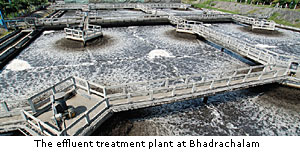In 2005-06, of the total 20.96 million KL wastewater, 86.8% (18.19 million KL) was used
for irrigation. 8.4% (1.76 million KL) was discharged to surface water bodies and balance
4.8% to the municipal drains/sewage.
The Bhadrachalam, Tribeni and Kovai units contributed 19.95 million KL
of the total treated wastewater discharged. Average monitored effluent levels in these
units, in 2005-06, were substantially lower than the National Standards:
The average Adsorbable Organic Halides (AOX) level in Bhadrachalam
effluents was 0.0025 kg/tonne of paperboard. This is remarkably below the average
discharge level of 2kg/tonne by Indian Paper/Paperboard mills. It is also significantly
better than the World Bank guidelines for new paper mills which stipulate a level of
0.2kg/tonne.
|
All values
average for the year
| BOD* |
100/30 |
26 |
9 |
5 |
| COD* |
250 |
176 |
57 |
83 |
| TSS* |
100 |
79 |
25 |
23 |
| * BOD - Biochemical Oxygen Demand, COD - Chemical Oxygen
Demand, TSS - Total Suspended Solids. All the above units are in mg/l. All figures rounded
off to the nearest digit |

|
